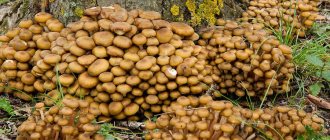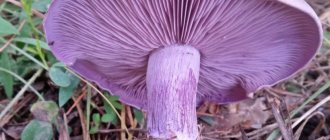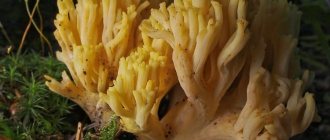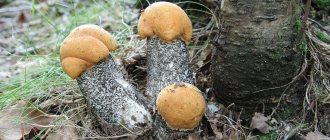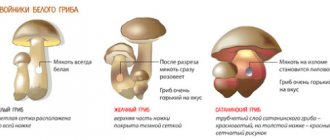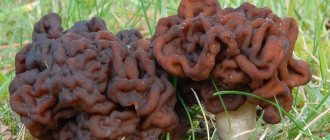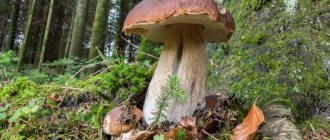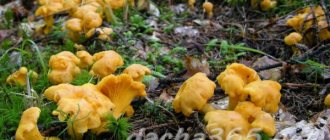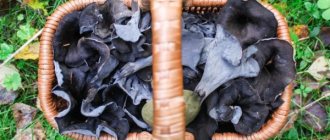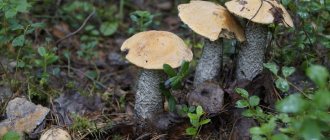Due to their appearance, chanterelles cannot be confused with other mushrooms. Their caps and legs look solid and seem to have no boundaries. The hat has an irregular shape, it is flat and has uneven edges.
It can be concave or funnel-shaped, which is why it resembles the shape of an inverted umbrella. The color is mostly yellowish or with an orange tint.
You can find chanterelles in the forest from early summer until mid-October. Mushrooms are often found near spruce, pine and oak trees. Especially in damp places, in moss, among leaves on the ground.
Chanterelles can be easily spotted as they grow in large groups. Below are photos of chanterelle mushrooms, which illustrate the above.
Distinctive features of chanterelle mushrooms
All types of mushrooms have a funnel-shaped cap up to 10 cm in diameter with a wavy, uneven edge. Color varies from light to dark yellow. When growing in groups, as often happens, the legs are curved and sometimes join together at the base of the mycelium. The veins on the stem are thick and run down the stem. Their shape is straight throughout the stem, but the veins bifurcate and are more sinuous closer to the cap. Chanterelles grow from 6 to 9 cm in height.
Spore print: Pale yellow to creamy white, sometimes with a slight pinkish tint. The gills are forked, the same color as the rest of the mushroom. They are straight or wavy and always flow down the stem.
Medicinal preparations of chanterelle
Powder is the easiest form to use. Take 1 tsp per 100 ml of water. ground dry mushrooms and leave for 30 minutes. Must be mixed before taking. Drink on an empty stomach, 1 hour before meals.
Alcohol tincture has shown itself to be positive in the fight against helminths. It is prepared from both fresh and dried chanterelles. For 150 ml of vodka - 3 tbsp. fresh mushrooms or 2 tbsp. dried. Keep in the refrigerator for 2 weeks. Drink 1 tsp before bed.
The extract is a finished granular product that can be purchased at the pharmacy. Used to kill worms.
Types of chanterelles
Common chanterelle
Distributed in European coniferous and mixed forests, North and Central America, Asia and Africa. This is an edible mushroom that can be easily identified even by an inexperienced mushroom picker.
The medium-sized common fox is yellowish, white, orange-yellow and rarely pink. The gills are the same color as the rest of the mushroom.
hat
At first it is convex, with a curled edge(s), but as the mushroom ages, it becomes funnel-shaped with a wavy edge. It can be quite irregular in shape. Older specimens are more orange, especially after a few rains. Specimens that receive a lot of sun discolor to a whitish color and have a slightly leathery appearance. In moist, mossy areas with shade, green moss forms on the caps of chanterelles.
Gills
They look like ridges that are quite wavy and always run down the leg.
Leg
The stem is usually as long as the cap is wide and the same color as the rest of the mushroom. The pulp is yellowish-white. The spore print is whitish or slightly yellow.
Enthusiasts begin searching for the mushroom in late spring, after the rains. Sometimes when the weather is humid, the fruiting body of the mushrooms is soggy with reduced quality. Depending on the region and latitude, July-October is the period when fruiting of the common chanterelle reaches its peak.
Gray chanterelle
hat
Barely convex when young. The edge subsequently widens, in the form of a wavy blade. The surface is villous-scaly, especially near the edge. The color is grayish with brown tints. The intensity of the tone depends on age and environmental conditions, it is lighter in dry weather and darker in humid weather.
Hymenophore
Formed by gills and folds, spaced and branched, very noticeable when fully developed, the color of this pseudohymenophore is gray with shades, bluish in young individuals, eventually acquiring a dark gray color after the spores mature.
Leg
Curved, grooved, spreads out like a fan during the development of the hymenophore. The color is similar to the shade of the cap, a little lighter, sometimes slightly faded near the base.
Habitat
This mushroom is not often encountered by mushroom pickers. In the growing areas there are quite a lot of gray foxes in deciduous forests, where they prefer chestnut groves and calcareous soils.
Cinnabar red chanterelle
Recognized by the characteristic flamingo-pink color and the presence of false gills on the underside of the cap. The mushroom is smaller and more graceful than other chanterelles and grows in deciduous forests.
Chanterelle cinnabar is mycorrhizal with hardwoods, especially beech and oak, aspen and other hardwoods. Grows alone, scattered or in a community in summer and autumn.
hat
Convex or broadly convex, bald, dry at a young age, becomes flat or shallowly sunken, enlarges and appears wavy. Color ranges from flamingo pink to "cinnabar red", pinkish orange or reddish orange.
The lower surface has well-spaced, well-developed false gills that run along the stem; Cross-veins often develop and are cap-colored or slightly paler.
Leg
Smooth in youth, but in maturity tapers towards the base, hairless, dry, colored like a cap or paler. The basal mycelium is white to pale yellowish in color. Pulp: whitish or the color of the cap, does not change color when cut. Smell and taste: the smell is sweet and aromatic; the taste is not distinctive or slightly spicy.
Velvety Chanterelle
The symbiotic mushroom grows under deciduous trees (chestnut and beech) and less often under coniferous trees. The fruiting period is summer and autumn.
hat
The mushroom is recognized by its thin and irregularly shaped cap, with a flexible surface, a bright orange cuticle and a wavy edge. In youth, the cap is convex and then funnel-shaped; the cuticle is finely scaly, orange or orange-pink, and fades with age.
Stem
The legs are straight, thick, paler in color than the cap.
Hymenophore
Lamellar, moderately branched, forked or reticulated, in the color of the cap. Flesh: Firm, whitish, yellowish or slightly pinkish. Exudes a faint apricot scent.
Faceted chanterelle
Found in Asia, Africa and North America singly, in groups or in clusters under deciduous trees. The mushroom produces fruiting bodies in summer and autumn
hat
Funnel-shaped top and wavy edges. The surface is dry, lightly covered with a layer of fine fibers, deep bright orange-yellow. Older specimens turn yellow, the outer edges of the cap become pale yellow, and in younger specimens they bend downward.
Hymenophore
The spore-bearing surface is initially smooth, but gradually channels or ridges develop on it. Small gills look like veins, less than 1 mm wide. The color is pale yellow and the same as the surface of the stem.
Stem
Quite thick, cylindrical, tapering towards the base. Inside, the legs are filled with fleecy mycelium, solid. Rarely are the fruiting bodies united with the stems at the base.
Pulp
Solid or partially hollow (sometimes due to insect larvae), pale yellow in color.
Chanterelle yellowing
A unique species, highly valued by gourmets, which is easily recognized by its “trumpet” shape, thin and small fleshy, brown and fringed cap. The stem is bright orange and internally empty.
hat
At first, deep in the center, it is convex, in the shape of an oblong tube, then it is more open, expanding, the edge is sinuous, lobed, sometimes jagged. The color is reddish-brown, the bottom is orange or darker brown-gray.
Hymenophore
Almost smooth and round, with slightly raised veins, sinuous and branched. The color is creamy yellow, orange-yellow, sometimes with a hint of pink, but the color is always less bright than that of the cap.
Stem
Tubular, hollow, smooth, straight or curved, very variable in shape, resembling a funnel with longitudinal grooves. The color is orange or egg yolk, sometimes with a hint of pink. The mushroom has a strong smell of fresh plums and a sweet taste.
Habitat
A symbiont mushroom that grows from late summer to late autumn, in groups of hundreds of specimens in coniferous (near pine) and deciduous forests.
Trumpet chanterelle
It forms mycorrhizae with coniferous trees in moss or on well-rotted, moss-covered logs in swamps.
hat
At first more or less convex, it soon becomes vase-shaped, at the final stage holes form in the center. The edges are wavy when mature. Smooth, sticky or waxy when fresh. The color ranges from dark yellowish-brown to blackish-brown, becoming greyish-brown or grayish with age. Sometimes radial patterns are slightly visible.
Hymenophore
Descends along the stem. Young mushrooms have ridges and folds. With age, false gills develop, which often branch and have cross-veins. The color is yellowish to grayish or brownish, sometimes slightly lilac.
Leg
It becomes empty with age, bald, with a waxy coating. Color ranges from orange to orange-yellow when young, dull yellow to brownish-orange as it ages. The basal mycelium is whitish to pale yellow. The taste is not distinctive; the smell is not obvious or slightly aromatic.
Growing
Chanterelles can be grown on your own plot. An important condition is to plant mycelium under trees that form mycorrhiza with them. These include spruce, pine, oak and beech. The tree should grow on your site.
Find out how long chanterelles can be stored in the refrigerator and in what form to store them.
There are three ways to plant mushrooms on your own territory:
- From forest mycelium. You can prepare the material yourself. To do this, go to the forest in September-October. Once you find a place where chanterelles grow, dig out the top layer of soil. There will be whitish fibers in the soil - this is planting material. Place the excavated soil in a bag or box and leave it in the cellar until spring. Do not cover the container with soil so that the mycelium is enriched with oxygen. By mid-spring, plant soil with mushroom fibers in holes previously dug in the garden.
- From purchased mycelium. To plant, you need to buy laboratory-grown material. You should also bring earth from the forest. The soil is taken from the plant near which the mushrooms will grow at home. That is, if you plant mycelium near a spruce, take soil near the same tree in the forest. Next, dig holes in your area, fill in the planting material, cover with the forest soil you brought and water.
- From mushrooms. Remove the stems from the collected mushrooms. Place the hats in a bucket and fill with water until the material is completely soaked. Add 100 g of sugar to 1 liter of water and stir. Cover the bucket and leave it to sit for a day, maybe even a day. When the caps are soaked in sweetened water, mash the raw materials into porridge and strain the liquid into a separate container. Dig holes near a suitable tree, pour in the expressed liquid and spread out equal parts of the mashed pulp. Bury the material with soil and water again.
Video: growing chanterelles at home
What is the difference between false chanterelles and edible ones?
2 types of mushrooms are confused with chanterelles:
Orange talker (inedible)
The fruit bodies of the mushrooms are yellow-orange with a funnel-shaped cap up to 8 cm in diameter, which has a felt surface. Thin, often forked gills on the underside of the cap run along the smooth stalk. Reports on the edibility of the mushroom are not always reliable. The mushroom is eaten, although it is not particularly aromatic. Some authors report that it upsets the gastrointestinal tract.
Omphalote olive (poisonous)
A poisonous orange gill mushroom that, to the untrained eye, looks similar to some species of chanterelles. Distributed in forested areas of Europe, where it grows on decaying stumps and roots of deciduous trees.
Unlike chanterelles, olive omphalotes have real, sharp, non-bifurcating gills. The inside of the leg is orange, chanterelles have a lighter inside.
How to distinguish false chanterelles from real ones - video
Habitats
You can meet chanterelles in different places. Like cockerels, they can grow in pine, spruce or deciduous forests. Most often, chanterelles are found in small-leaved and coniferous plantations with a sufficient amount of moss. They prefer to grow in the shade, but if the weather is not hot and rainy, then they feel great in open areas.
Like their counterparts of other species, chanterelles like to grow in groups. Moreover, their groups are numerous and appear en masse after thunderstorms. Mushrooms must be collected carefully, cutting them off so as not to damage the mycelium.
Important! Mushrooms that grow not far from the road cannot be used for food. Even if they look quite appetizing, such fruits will do more harm than good, because they tend to accumulate harmful substances and heavy metals.
Benefits of chanterelles for human health
Like any other forest mushrooms, chanterelles are a tasty and healthy food that contains:
- a large amount of vitamin D2, it helps the human body absorb calcium;
- significant amount of protein;
- vitamin A;
- potassium;
- iron;
- chromium;
- eight essential amino acids that are valuable for the human body.
This type of fungus is quite intolerant to elevated levels of nitrogen and is not found in areas with high levels of air pollution. It is a mycorrhizal species and is therefore always associated with trees that do not adversely affect human health, including oak, beech, pine and birch.
The fruiting bodies are relatively long-lived, partly because they resist fungal parasites and are rarely eaten by larvae. It's nice to know that the harvested crop is not affected by arthropods. This feature contributes to the popularity of chanterelles as an edible species!
Beneficial features
Chanterelles are popular among mushroom lovers. But besides taste, they are valued for their beneficial properties. They contain a lot of carotene, which provides the bright color of the mushroom, and there are other useful substances.
Chanterelles contain more manganese than other mushrooms, about 1/5 of the daily requirement required by the body. There is also a high content of vitamins:
- RR ¼ of the daily value in the raw product;
- A – about 15%;
- beta-carotene – 17%.
Contains the following:
- trace elements: selenium, zinc, copper;
- macroelements: phosphorus, sulfur, calcium.
But there are some substances that make this mushroom special:
- Polysaccharide of chymomanosis. This substance has the property of destroying parasites and worms in the human body. Moreover, the substance is completely natural, so it does not cause side effects. Its action is selective and does not affect liver function. Moreover, not a single parasite can survive exposure to chymomanosis.
- The polysaccharide ergosterol, also known as provitamin D2, which cleanses the liver, including parasites that like to settle in it. The effect of this substance on enzymes helps improve liver function.
- Tramentolinic acid and K-10 polysaccharide, which are found in chanterelles, fight the hepatitis virus.
For those who limit the amount of calories they consume, chanterelles will be a godsend.
100 g of chanterelles contains:
- 19 kcal;
- 1.5 g proteins;
- 1 g each of fat and carbohydrates;
- 7 g dietary fiber.
These mushrooms are good for digestion and are quite appropriate in the diet of those who are on a diet. They contain 89% water, so during the cooking process they decrease in volume by 3-4 times.
How chefs prepare chanterelles
There are many different recipes for preparing chanterelle dishes in the world. Some people use them in soups, others make pasta sauces from them, and others salt them. Gourmets consume it with sweets and jams. In the end, no matter how you prepare the chanterelles, they are delicious!
Chanterelle is a truly wonderful mushroom when fried. Once dried, it is an excellent seasoning for dishes when used in small quantities. When used in large doses, it becomes an excellent natural flavoring agent.
The taste makes chanterelle suitable for chicken, veal, pork, fish, vegetables, rice, pasta, potatoes, eggs, nuts and fruits. It is not recommended to mix chanterelles with strongly flavored products.
Vinegar, oil or mushroom-flavored liqueur are prepared from ground chanterelle powder.
Contraindications, use with caution
Like any other product, chanterelle mushrooms have their contraindications.
First of all, every gourmet should remember that any type of mushroom is considered a heavy, difficult to digest food, chanterelles are no exception. It is necessary to eat forest fruits within reason, since uncontrolled “overeating” can lead to serious disruptions in the functioning of the gastrointestinal tract. People suffering from chronic diseases of the above-mentioned gastrointestinal tract, that is, digestion, should completely abandon the product.
A separate group of people who are not recommended to feast on any types of mushrooms are children under 5-6 years of age. The same applies to elderly, weakened people, as well as women who are in an “interesting” position or are breastfeeding.
Allergy sufferers and those who have an individual intolerance to one or more components of other mushroom cultures can eat mushrooms with caution.
There are no other warnings, the main thing is to know when to stop.
Cooking recipes
So, if you are lucky and have collected a whole basket of white chanterelles, it’s time to cook delicious dishes from them. After all, it is in their fresh form that they are very good, and also have all the necessary set of useful properties.
What recipes should you pay attention to?
Fried chanterelles
- You need to pre-process the mushrooms. They are washed well with water and all dried or foreign elements are removed.
- Dry with a towel.
- Then, the chanterelles are cut exactly in half. Mushrooms are too big for quartering.
- The frying pan is hot and the onions are fried on it.
- Then, after 2-3 minutes, you need to throw in the mushrooms and fry for about 5 minutes, stirring constantly.
- Salt and pepper to taste.
- Then add a little sour cream and simmer the chanterelles for 10 minutes.
It will be a very tasty addition to the main dish.
Salad with chanterelles
You will need some onions, eggplant, cheese, butter and milk. Other products are added at your request.
- First you need to make the sauce. To do this, milk and cream are combined and heated in a water bath. Parmesan is added to it and everything is whipped with a blender.
- Meanwhile, the chanterelles are fried with onions. Parsley and tomatoes are also added there.
- Eggplants are cut randomly.
- Parmesan is grated on a coarse grater.
- All ingredients are combined and poured with sauce.
How long to cook white chanterelle?
If you need the mushroom boiled, then in this case, it must be cooked correctly. It is important to maintain a balance here. An undercooked chanterelle may not have the most pleasant taste and consequences for you. But an overcooked mushroom will simply fall apart, and its taste properties will not be preserved.
So, how to cook chanterelle correctly?
If the mushroom is small in size, that is, its cap is approximately 5 cm in diameter, then in this case it should be thrown immediately into boiling water. At the same time, you need to cook it for 5 minutes. This will be quite enough to achieve the desired effect.
But if the mushroom is large enough, the cap reaches about 8 cm in diameter, then you are recommended to cook for 10 minutes. This is quite enough to achieve good results.
How to cook soup?
If you need to cook soup, you need to follow this method.
Put the water to boil. You can pre-cook the broth.
Then, chopped potatoes, carrots, onions and other vegetables that you need are placed in the pan. By the way, broccoli goes perfectly with chanterelles.
Then, 10 minutes before readiness, chanterelles are placed in the soup, cut in half or into four parts, depending on their size. Cook for 10 minutes, after which the soup is salted, pepper is added and it is removed from the heat. You can throw parsley on top. It turns out very tasty.
Chanterelles are peaceful forest inhabitants who delight us not only with their delicious food, but also with their appearance. In order to get real pleasure from eating them, it is important to be able to distinguish chanterelles from other representatives of forest inhabitants. And in this case, you will certainly be pleased with the contents of your basket.
